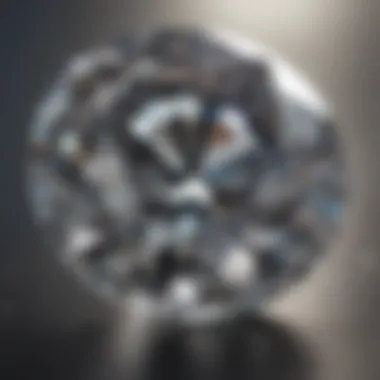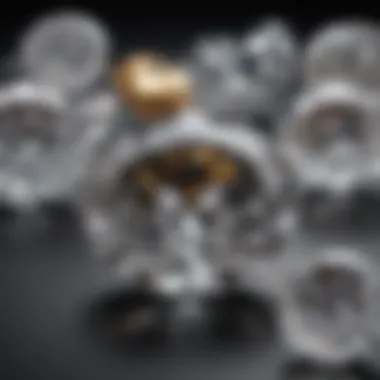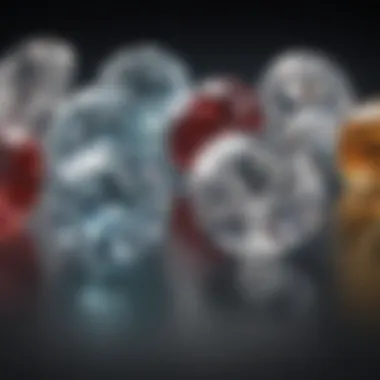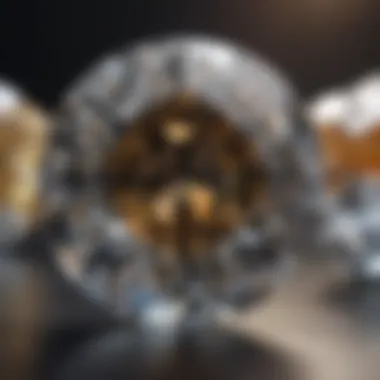Diamond Carat Comparison: Size, Value, Perception


Intro
When it comes to diamonds, the carat weight is often the first attribute that catches the eye. However, understanding how carat size impacts value and perception is essential for anyone considering a diamond purchase. This section introduces the core concepts surrounding diamond carat comparison, shedding light on its significance in the broader scope of gemstone valuation.
Gemstone Overview
Diamonds are among the most coveted gemstones in the world. Renowned for their brilliance and durability, these gemstones have captivated humans for centuries. A diamond is a crystalline form of carbon, formed under extreme pressure deep within the Earth.
Description of the gemstone
Diamonds come in various shapes and cuts, with the round brilliant cut being the most popular. Each diamond’s unique characteristics, such as its inclusions, color, and clarity, play a significant role in determining its overall beauty and market value. Their captivating sparkle makes them desirable not only in jewelry but also as a symbol of status and love.
Physical properties
Diamonds exhibit several noteworthy physical properties:
- Hardness: Diamonds score a 10 on the Mohs scale, making them the hardest natural substance.
- Brilliance: Due to their unique optical properties, diamonds reflect light in stunning ways that other gemstones cannot replicate.
- Thermal conductivity: Diamonds have excellent thermal conductivity, meaning they can conduct heat away more quickly than other materials.
These properties not only enhance the diamond's allure but also contribute to its value in the marketplace.
"The allure of diamonds lies in their timeless beauty and unmatched durability, making them a perpetual favorite among consumers."
Carat Weight and its Influence on Value
Carat weight is a primary factor in determining the value of a diamond. Each carat is equivalent to 200 milligrams. As the carat weight increases, the price per carat often rises exponentially. This discrepancy is essential for buyers to grasp, as it influences their choices significantly.
Visual Characteristics
The visual impact of carat weight can be substantial. For instance, a one-carat diamond may appear noticeably smaller than a two-carat diamond, even though the weight difference is minimal. This perception can greatly affect consumer buying behavior, proving that perceived value is just as important as actual size.
Market Dynamics
Understanding the relationship between carat weight, size, and market trends is vital for informed purchasing decisions. Various factors influence the market:
- Demand: High demand for larger stones can drive prices higher.
- Rarity: Larger diamonds are rarer, contributing to their elevated prices.
- Trends: The rise of particular styles, such as vintage or halo settings, can impact consumer interest in different carat sizes.
Recognizing these dynamics helps consumers navigate the complex marketplace and make choices that align with their preferences and budgets.
As this article progresses, further exploration will reveal the nuances surrounding diamon carat weight, delving into dimensions, visual characteristics, and the interplay of market trends.
Understanding Carat Weight
Understanding carat weight is essential in the realm of gemstones, particularly diamonds. Carat weight directly influences a diamond's value, marketability, and consumer perception. As a carat indicates the weight of the stone, it serves as a primary attribute when evaluating diamonds. Consumers must grasp how carat weight impacts the options available in jewelry. By doing so, they can make informed decisions that align with their personal preferences and budget.
Definition of Carat
The term carat originates from the carob seeds historically used as a weighing standard for gemstones. Today, a carat is defined as 200 milligrams. This standardized measure allows for consistency in evaluating weight across the diamond market. Generally, diamonds range from fractions of a carat, such as 0.25, up to several carats over 5. The weight of a diamond significantly affects pricing, with larger stones commanding higher prices per carat. Understanding this definition will help consumers appreciate the relationship between a diamond's size and its value.
Carat vs. Size
Many consumers often equate carat weight with the physical size of the diamond. However, these two measurements are not identical. A diamond's size is influenced not only by its carat weight but also by its cut, shape, and dimensions. For example, a well-proportioned round diamond will appear larger than a poorly cut diamond of the same carat weight.


Factors that impact size perception include:
- Cut Quality: A diamond with optimal cut proportions will reflect light better, enhancing its perceived size.
- Shape: Different shapes can influence how large a diamond appears. For instance, elongated shapes like oval or marquise may appear larger than round diamonds of the same weight.
- Table Size: The table is the flat surface on top of the diamond. A larger table can create the illusion of a bigger diamond.
- Setting Style: The way a diamond is set can also affect its perceived size. Settings that use prongs to lift a stone higher can make it appear larger.
In summary, while carat weight is a critical metric in diamond evaluation, understanding its distinction from actual size is vital for consumers aiming to make educated purchases.
Dimensions of Diamonds
Understanding the dimensions of diamonds is not merely an exercise in measurement. It is a vital component in the evaluation of a gemstone’s beauty and overall value. The dimensions, including cut proportions, shape, and physical characteristics, determine how light interacts with the diamond, greatly affecting its brilliance and fire. Consequently, this section will elaborate on the intricate details that constitute diamond dimensions and their significance for buyers, collectors, and designers alike.
Physical Characteristics
The physical characteristics of a diamond are foundational to its allure. They consist of the diamond's width, depth, and table size, each contributing uniquely to its appearance. The table refers to the flat top surface of the diamond, while the depth is measured from the table to the point or culet of the stone. Achieving balance between these elements is crucial.
For example, a shallow diamond may lack brilliance as it allows light to escape rather than reflecting it. Conversely, a deep diamond can also appear smaller than its carat weight suggests. This phenomenon may mislead buyers when evaluating size versus perceived visual weight. Understanding these characteristics is essential for making informed purchasing decisions.
Table and Depth Percentage
Table and depth percentages are specific measurements that help in assessing the cut quality of the diamond. These percentages are ratios of dimensions relative to each other, reflecting how well the diamond can reflect light. A well-proportioned table typically falls between 53% to 60% of the width, while the ideal depth percentage ranges from 60% to 62.5%. If the table is too large relative to the diamond's depth, it will reflect less light, diminishing its brilliance.
When aiming for quality in cut, both table and depth percentages together should produce an optimal light performance.
Buyers should pay attention to certificates from grading organizations such as the Gemological Institute of America (GIA), which provide detailed cut grades and measurements, ensuring clarity in understanding these numbers.
Influence of Shape on Size Appearance
The shape of a diamond is another significant factor influencing how its size is perceived. Different shapes reflect light differently and can alter the visual size of the stone. For instance, round diamonds tend to exhibit more brilliance than fancy shapes. However, a 1-carat marquise or oval shape might visually appear larger than a round diamond of the same weight.
This variance is important for those seeking to maximize the perception of size without increasing carat weight. Collectors and buyers should explore various shapes and how they may fulfill personal style while balancing visual appeal against budget considerations.
Evaluating the dimensions and their impact is crucial for making knowledgeable choices in the realm of fine jewelry, cementing the foundation of effective diamond comparison and selection.
Carat Weight and Pricing
Understanding the relationship between carat weight and pricing is crucial for anyone interested in purchasing diamonds. Carat weight directly correlates with the price of a diamond, but this association is influenced by various other factors, including quality and market demand. This section will explore the nuances of pricing structures, market trends, and how different carat weights compare in terms of value.
Pricing Structure of Diamonds
The pricing structure of diamonds is complex. Generally, the price increases with carat weight. However, it does not increase linearly. A diamond that weighs twice as much does not cost exactly double. Instead, prices rise exponentially, reflecting both rarity and demand.
Factors influencing diamond pricing include:
- Quality of the Cut: A well-cut diamond can reflect light better, thus increasing its value.
- Clarity: Diamonds with fewer visible inclusions are more valuable.
- Color: Colorless diamonds tend to be priced higher.
- Shape: Certain shapes are more sought after in the market.
Each of these factors compounds the effect of carat weight on price. The overall cost also depends on current market conditions and consumer interest.
Carat Weight and Market Trends
Market trends play a significant role in determining the value of diamonds concerning carat weight. As consumer preferences change, so do the prices attached to different carat weights. For example, larger diamonds have seen increased demand as luxury items. This trend results from the luxury market's growth and celebrity influence, which drives interest in bigger stones.
Conversely, smaller diamonds have fluctuated in desirability, with some consumers starting to favor ethical and sustainable options that may lead to a shift in purchasing behaviors. Understanding what's trending can give buyers insights into when to purchase diamonds.
Comparison of Carat Weights in Pricing


When comparing carat weights in terms of pricing, it’s important to recognize the price jumps that occur at certain weight thresholds. This section will outline how pricing varies between various carat weights:
- 0.5 Carats: The entry point for many buyers, often priced affordably.
- 1.0 Carats: This carat weight typically marks a profit threshold, with prices increasing significantly.
- 1.5 to 2.0 Carats: The increase in price can be steep, demonstrating how demand influences value.
- Above 2.0 Carats: Stones of this size are rare and often fetch high prices, partly due to their scarcity.
"The price of diamonds is not just about size, but the intricacies of supply, demand, and consumer preferences."
Understanding these distinctions can help buyers make informed choices while considering their budget and preferences. Additionally, potential buyers must remember that just focusing on carat weight may lead to overlooking other crucial aspects of a diamond's quality.
Perceived Value of Carats
Understanding the perceived value of carats is critical in the context of diamonds. This section illuminates how the carat weight influences not just the monetary value but also the emotional and psychological significance that consumers associate with diamonds. A diamond's carat size can sometimes overshadow other factors such as clarity, color, and cut. This can lead to a skewed assessment of overall value.
The perceived value is rooted in aspects like consumer psychology, cultural connotations, and effective marketing strategies. Each of these elements shapes how potential buyers view and appreciate diamonds.
Consumer Psychology
Consumer psychology plays a significant role in shaping perceptions of value. When a buyer sees a larger carat weight, there is an immediate association with greater worth. The cultural narrative that equates size with status reinforces this belief. Psychological factors, such as the fear of missing out, further compel consumers to opt for higher carats, often without fully considering their needs or budget.
Moreover, peer influence cannot be discounted. Individuals often gauge their choices against social norms and expectations, which play a crucial role when selecting diamond jewelry. The desire for acceptance and admiration can drive purchases beyond practical considerations.
Cultural Influences on Perception
Cultural influences add another layer to the perceived value of carats. In many societies, larger diamonds symbolize love, commitment, and financial success. For instance, in Western cultures, it is common to associate gemstone size with the seriousness of the relationship. The larger the carat weight, the more love and investment are believed to be behind the gift.
Global cultural contexts can differ significantly. In some cultures, the importance of diamond size may be secondary to other attributes, such as craftsmanship or the uniqueness of the stone. This variability highlights the importance of cultural backgrounds in shaping perceptions related to carat size and value.
Marketing Impact on Consumer Choices
The marketing strategies employed by jewelry retailers heavily influence consumer choices regarding carat weight. Advertising often emphasizes size to attract buyers, creating a perception that a larger diamond is inherently better. Tactics may include using high-profile endorsements or showcasing luxurious lifestyles to set a desirable benchmark.
Retail pricing structures also play a role. Often, prices increase exponentially with carat weight, creating a mental link that larger equals better. This marketing approach can lead consumers to overlook other essential factors in diamond valuation, such as clarity and cut.
"The power of perception can significantly impact a consumer's decision to invest in a diamond, often prioritizing size over other qualities, illustrating the complexity of diamond valuation."
In summary, the perceived value of carats encompasses psychological factors, cultural narratives, and marketing messages. Understanding these components is vital for navigating the world of diamonds and making informed decisions.
Carat Comparisons: Visual Analysis
The analysis of carat comparisons through visual means holds a special significance in understanding diamonds. This component plays an essential role in how potential buyers perceive the value and aesthetics of different carat sizes. Visual analysis provides a clear frame of reference, allowing consumers to grasp size differences that may not be immediately discernible in numeric terms alone. Not only does this aid in making informed choices, but it also enriches the buying experience by bringing clarity to the complex nature of diamond purchasing decisions.
Visual elements offer numerous benefits. They can highlight nuances in appearance and setting that affect perception greatly. For instance, two diamonds can have the same carat weight but look very different based on the shape or quality of the cut. A well-designed chart, displaying various visual comparisons, becomes an invaluable tool, serving both educational and practical purposes.
When considering carat comparisons visually, it is important to factor in the specific style of the diamond. Shapes like round or princess cuts reflect light differently, influencing how size appears. This, paired with the context of the setting in which the diamond is placed, can dramatically transform the viewer's perception of size and value. With these aspects in mind, the visual analysis of carat sizes emerges as not just a supplementary tool but a crucial component of the diamond selection process.
Comparison Charts and Visuals
Comparison charts and visuals are fundamental in the realm of diamond carat analysis, as they distill complex information into more digestible formats. These visual aids serve to simplify the often overwhelming data surrounding diamond dimensions and carat weights. In a side-by-side format, buyers can easily see differences in size, shape, and setting compatibility. This clarity helps to eliminate ambiguity, allowing consumers to make choices with confidence.
When utilizing comparison charts, one should consider these key elements:
- Carat Sizes: Display different carat weights alongside their physical dimensions to illustrate how size varies.
- Shape Variations: Include various shapes to demonstrate how they affect visual perception very differently.
- Setting Examples: Offer visuals that incorporate different types of settings to discuss their impact on the overall appearance.


A well-crafted comparison chart can support discussions around how larger carat weights can sometimes be less visually impactful than smaller, well-cut stones. This feature invites discussions on quality versus size, enriching the reader's understanding.
Case Studies of Different Carat Sizes
Exploring case studies of different carat sizes provides real-world contexts to illustrate the concepts discussed. Each case study can draw upon varying consumer experiences and preferences when selecting diamonds of specific carat weights.
For instance, one could analyze a consumer's choice between a one-carat round diamond and a 1.5-carat cushion-cut diamond. The study might highlight how the buyer valued brilliance over size, ultimately leaning toward a smaller but higher quality diamond. Another case could involve comparing a two-carat diamond set in a simple band with a three-carat diamond in a more ornate setting, where perceptions of value greatly differ based on context and design.
Such case studies emphasize that personal preference and individual lifestyle play a significant role in purchasing decisions. They can also reveal cultural influences and market trends that impact perceptions of carat weight. Presenting actual examples allows readers to connect theoretical knowledge to tangible choices, fostering a deeper appreciation for the nuances involved in carat comparisons.
By synthesizing visual data with practical insights from various cases, the section reinforces how substantial understanding of carat sizes can greatly enhance diamond purchasing experiences.
Choosing the Right Carat Size
Choosing the right carat size is a pivotal aspect in the diamond purchasing journey. A diamond's carat weight can significantly impact its price, appearance, and the perception of value. Understanding how carat size fits into overall preferences and requirements can assist consumers in making well-informed choices. This segment breaks down essential factors to consider when selecting the ideal carat size.
Budget Considerations
One of the most critical elements in the decision-making process is the budget. The price of diamonds escalates sharply with an increase in carat weight. For instance, a one-carat diamond may cost significantly less than a diamond that weights slightly more. Understanding the pricing structure is fundamental.
- Set a Firm Budget: Before even considering carat weight, it is wise to determine a clear budget. Understand not only the maximum amount you are willing to spend but also analyze what that budget corresponds to in various carat weights and qualities.
- Consider Total Cost: Remember that the cost of a diamond does not rest solely on its carat weight. Other factors, such as clarity and color, will also influence the final price. A smaller diamond of higher quality might be a more appealing option than a larger stone with noticeable inclusions.
- Market Trends: Keep an eye on market trends. Prices may fluctuate based on demand and supply dynamics. Research current market conditions can provide additional insight into when might be a good time to make a purchase.
Personal Preferences and Lifestyle
Another layer to consider relates to personal taste and lifestyle. The size and appearance of a diamond should align with the wearer's preferences and everyday life.
- Lifestyle Compatibility: Assess how often you will wear the diamond. If it's a piece intended for daily wear, a smaller carat size may be more practical, as larger stones can draw more attention and potentially become damaged more easily.
- Fashion Sense: Personal style is essential. A diamond's carat size can either complement or contrast fashion choices. Delicate settings with smaller sizes may suit those who prefer subtlety, while bolder individuals might thrive with larger carats.
- Symbolism: Symbols carry weight. For many, diamonds signify love and commitment, and the carat chosen often reflects personal meanings associated with these milestones. Choose a size that resonates beyond mere aesthetics.
Setting and Style Compatibility
The setting of a diamond plays an influential role in its overall appearance. Carat size should work harmoniously with the chosen design.
- Prong vs. Bezel Settings: A prong setting often allows more light to interact with the stone, enhancing its brilliance. That said, a bezel setting can make the diamond appear larger while providing added protection for the stone. Consider how carat size interacts with different settings.
- Ring Size and Shape: The size of the ring and the finger can impact how the carat weight appears. A larger hand may balance a larger stone better than a smaller hand, where a smaller carat might be more suitable.
- Matching Other Jewelry: Consider existing pieces in your jewelry collection. The chosen carat size should not only stand out but also fit well with items already owned, ensuring that aesthetic choices don't clash.
Choosing the right carat size combines budget, personal taste, and setting to produce a diamond that truly resonates with the wearer.
Closure
The discussion on diamond carat comparison has highlighted several key factors influencing how we perceive size, value and overall desirability of diamonds. It is essential to recognize that carat size is not just a number; it encapsulates a wealth of information regarding market trends, consumer perceptions, and personal preferences. With this understanding, buyers can make more informed decisions when investing in a diamond.
When considering a diamond, evaluating the carat weight allows consumers to weigh their budget against their unique preferences. It also intertwines with physical dimensions and how these dimensions visually appear. With these aspects in mind, one can see that carat size directly correlates to not only the financial investment but also the emotional significance of a gemstone.
Summary of Insights
In summary, the insights from this article reveal the intricate balance between carat size and perceived value. Key points to take away include:
- Carat weight impacts pricing significantly. Larger stones typically command higher prices, not just due to size but also market desirability.
- Psychological factors affect buying behavior. Many consumers associate larger carats with higher value and significance.
- Cultural trends play a role in shaping perceptions about what constitutes an ideal diamond size. Understanding local preferences can guide better purchasing decisions.
This synthesis serves as an instrumental tool as readers navigate their diamond purchasing journey.
Final Thoughts on Carat Size
The exploration of carat size culminates in the understanding that size matters, but it is not the sole factor to consider. Many aspects intertwine to define the value of a diamond, including cut, clarity, and color. It is prudent for buyers to assess their priorities holistically rather than fixating solely on carat weight.
Investing in a diamond is a personal journey. Therefore, understanding the various layers that affect carat perceptions allows buyers to make choices that resonate with their identity and values. In a world that values both aesthetics and significance, being informed can elevate one’s buying choices beyond the superficial.
"In diamonds, as in life, understanding the deeper truths leads to wiser decisions."
Consequently, future buyers should approach their selection with a broader lens, ensuring they account for both personal tastes and market norms.







